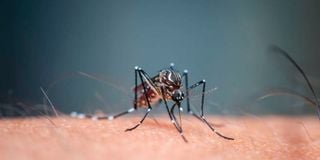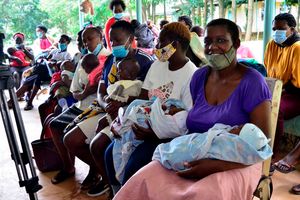Smarter, more evasive and deadlier mosquitoes on the prowl

A mosquito sucking blood.
What you need to know:
- This deadly insect is no longer waiting indoors for humans to retire in bed but has developed complicated outdoor hunting and feeding skills.
- It has also upped its survival tricks
Did you know that mosquitoes have more than 150 receptors? Well, scientists have found out that this high number of receptors helps mosquitoes easily locate victims to bite. And when malaria-causing female anopheles mosquitoes go hunting for blood, they track the carbon dioxide that humans exhale.
But along the way, the dynamics of the transfer of plasmodium parasites from a mosquito to humans are changing, thanks to genome mutations. One scientist who has witnessed the trend is Milcah Gitau, who has just called it a day after 52 years of diligent service to science at the International Centre of Insect Physiology and Ecology (Icipe) in Nairobi.

International Centre of Insect Physiology and Ecology research officer Milcah Gitau demonstrates how mosquitoes are fed.
Mosquitoes, she tells Health Nation, during a visit, are becoming smarter, more evasive, bite during the day and not at night as they used to, apart from the fact that they are adapting to and fighting off many of the interventions experts are putting in place.
Ms Gitau is not surprised that in 2017, Kenya missed its malaria elimination target; with experts warning that mosquitoes have upped their survival tricks.
“My work has been to bring the enemy closer so that we can make headways in the research we have been doing. I have oversaw the breeding of several species of mosquitoes, which include the anopheles gambiae, anopheles arabiensis, culex quinquefasciatus and aedes aegypti to control vector-borne disease and other emerging infectious diseases brought about by mosquitoes because rearing is my passion. I am so happy Icipe gave me the job I love most,” the researcher expounds.
She has been in charge of the Icipe unit, which blocks malaria parasite transmission to humans; overseeing the supply of 6,000 to 8,000 of all stages of mosquitoes from larvae to adults per day and producing 14,000 to 16,000 pupae per day for supply and continuation of the colonies.
Ms Gitau highlights that mosquitoes are highly attracted to light — phototaxis. However, it does not apply to all spectrums of light as mosquitoes prefer ultraviolet light.
For this reason, it is commonly thought that yellow and red lights will repel mosquitoes. Although these lights do not necessarily act as a repellent, yellow or red outdoor lights will also not attract them.
Trapping systems
This explains why scientists have taken advantage of social and behavioural factors of mosquitoes to come up with solar-powered mosquito trapping systems (SMoTS) for malaria elimination on Rusinga Island in western Kenya.
“You can just be going about your day then you hear their annoying buzzing noises, it’s so irritating and the repellants I use don’t seem to work,” Ann Wairimu, a Nairobi resident, says.
For Mike Lusiola, who works from home in Nairobi, he can’t work in peace during the day nowadays. “I think I attract very many mosquitoes and lately they seem to bite me more during the day,” he tells Healthy Nation.
Dr Dan Masiga, the head of human and animal health at Icipe , discloses that outdoor biting has lately received increasing attention regarding control of malaria towards elimination while citing a new modeling study, which predicted that across Africa, outdoor transmission resulted in an estimated 11 million additional malaria cases annually.
The multi-country study done in Cameroon, Kenya and Ethiopia found high malaria transmission outdoors compared to indoors. In Kenya, monitoring efforts have assessed the malaria epidemiologic landscape and identified the key vector species; with primary malaria vectors belonging to the anopheles gambiae sensu and anopheles funestus vector groups, like most of East Africa.
“Of the mosquitoes morphologically identified, anopheles funestus was predominant across the three study areas namely Kerio Valley, Nguru-man and Rabai comprising 90.6 per cent (639/705) of the total captures while only 9.4 per cent (66/705) were anopheles gambiae.”
Genome mutations have been reported in Kerio Valley (anopheles funestus s.l.=478, anopheles gambiae s.l.=46); Rabai (anopheles funestus s.l.=72, An. gambiae s.l.=0) and Nguruman (anopheles funestus s.l.=89, anopheles gambiae).
The scientists highlighted that they detected mutations in the GSTe2 gene conferring resistance to pyrethroid – a pesticides similar to the natural pesticide from pyrethrum - in the anopheles funestus and anopheles longipalpis vectors.
These findings, especially in Kerio Valley, potentially pose a risk to insecticide-based control measures and mosquito killers. It is the first report of the detection of this resistance marker in any species apart from anopheles funestus.
“Overall, these findings may be useful in updating the risk map of key vectors in Kenya and providing evidence-based decisions in selection and implementation of appropriate interventions against malaria in the study areas,” the researchers added.
A second Icipe study analysed female specimens of the anopheles funestus complex collected from randomly selected consenting house-holds in diverse sites in the different epidemiological risk zones for malaria. “We analysed 1,149 specimens of which 87 (7.6 per cent) did not amplify in PCR. Of the 1,062 that successfully amplified, 627 specimens originated from indoor sampling and 435 from outdoor sampling.”
The Kenya Medical Research Institute’s (Kemri) latest findings on mosquitoes paint a picture similar to what Icipe has found.
“The malarial vectorial system in Africa is complex, typically of anopheles gambiae, An. arabiensis, and An. funestus as the primary vectors and a number of complementally vectors including An. pharoensis, An. coustani and An. Rivurolum,” Kemri states in a study done by Dr Joseph Mwangangi , the acting deputy director in-charge at the Centre for Geographic Medicine Research, and his team.
“Traditionally, malaria transmission in much of Africa has been dominated by An. gambiae and An. Funestus, which primarily feeds and rests indoors, our results show that indoor malaria transmission is mainly perpetuated by An. arabiensis, An. funestus and An. Coustani, while outdoor transmission is sustained by An. Coustani,” Kemri highlights.
“However, our results support previous findings that considerable investment in methods that target mosquito populations outdoors is urgently needed to sustain existing levels of malaria control and to make further inroads towards malaria elimination.Currently in Africa, there is no intervention that specifically targets outdoor biting mosquitoes.”
Scientists have also established that the anopheles stephensi, which was first detected in Africa, specifically in Djibouti in 2012, has now been found in cities and towns in urban settings in Ethiopia, Sudan and Somalia.
“We are doing more surveillance and more analysis in coastal, eastern and northern Kenya, specifically places like Mandera and Garrissa which I suspect may harbour the anopheles stephensi,” Dr Mwangangi told Healthy Nation.
According to Kemri’s provisional guidelines for monitoring stephensi, once the areas to be monitored have been determined, a sampling protocol can be developed. An. stephensi larvae are often found in “wells, overhead or ground-level water tanks, cisterns, tanks, coolers, roof gutters, or other artificial containers,” therefore, these types of larval sites can be targeted and monitored. But the An. stephensi are often quite zoophilic, so monitoring such types of sites in areas near or inside of animal shelters/pens may be particularly productive.
For aedes aegypti mosquitoes, which exist in densely populated cities and whose genetic components have high affinity for humans, their human-seeking behaviour can be traced to two environmental conditions: climate change and urbanisation. New findings published in Current Biology, a global peer reviewed journal, show that it is these species that are responsible for the vast majority of mosquito-borne illnesses suffered around the world.
“A. aegypti, is the main vector for diseases including dengue, Zika, chikungunya and yellow fever. This species spreads diseases that make over 100 million people sick each year,” scientists state.
According to Carolyn McBride , an assistant professor of ecology and evolutionary biology and neuroscience at Princeton University, what sets this species apart is that it specifically targets humans but not all mosquitoes within this species show the same affinity for humans.
Dr Willis Akhwale, the African Leaders Malaria Alliance (Alma) senior advisor , explains that science has now shown that mosquitoes are more attracted to some people than others and the reason to that is partially genetic.
“Mosquitoes need our blood protein to make their eggs, in the past we used to say certain blood groups but now scientists are looking at DNA variations,” he says while explaining that there are particular spots on a human being’s DNA that are more or less likely to make them attractive to mosquitoes.
Recently, global researchers recruited 18 pairs of identical twins and 19 pairs of fraternal female twins then used the Y-tube test to determine the mosquito attractiveness of each.
They measured by looking at the fraction of mosquitoes that correctly flew into the arm of the tube where each twin stood and found that the correlation was higher in identical twins, which strongly suggested that genetics influence determines how attractive one is to mosquitoes since identical twins share more of the same gene than fraternal twins, which explains why their mosquito attractiveness is closely related.
The malaria advisor further explains that lately scientists are now using Artificial Intelligence (AI) to deal with mosquitoes; thanks to technological advancements. “As experts we have begun to use machine intelligence to augment the decision-making abilities of officials and explore more effective malaria policy interventions by using different AI algorithms or ‘agents’ to determine the most effective intervention strategies for specific locations.
In 2018, researchers from Cornell University used multiple Artificial Intelligence (AI) agents to determine more effective malaria policies based on a combination of distributing long-lasting insecticide-treated nets and performing indoor residual spraying programmes.
“We ran these computational experiments to simulate a region in Western Kenya over a five-year intervention period into the future. Using a combination of advanced computer infrastructure and AI we can demonstrate that it’s possible to determine higher performing future intervention strategies for a particular region,” they said.
“This is crucial because as with anything, people find it difficult to deal with vast strategy spaces and sometimes our decisions can be prejudiced from past experience, lack of time or influence. We’ve developed the AI agents as “expert advisors”, to help support policy makers, looking for more cost-effective intervention strategies.”
On the other hand, Kemri’s Dr Mwangangi is of the view that the current ivermictin mass trial for malaria ongoing in the country in Kwale County will bear fruit. Kenya was last month selected for a mass administration malaria trial of the antiparasitic drug discovered in 1975 and used to treat head lice and heartworms in cattle.
A similar trial was conducted in Mopeia district, Mozambique, under the BOHEMIA project, which apart from settling on Kenya seeks to find out whether the popular veterinary drug can be used to treat malaria.
“Mosquitoes have been adapting to other interventions already in place, if we find that ivermectin is working, it will really help us realise the reduction of clinical malaria,” Dr Mwangangi believes.
Mozambique and Kenya are very different in terms of epidemiology, social structures, and climate conditions and such diversity of data could play a crucial role in informing policy decisions in the future.
“There is a lot of change in climate due to increase in temperature and so we might get more invasive mosquitoes as storage of water increases.”
[email protected]




